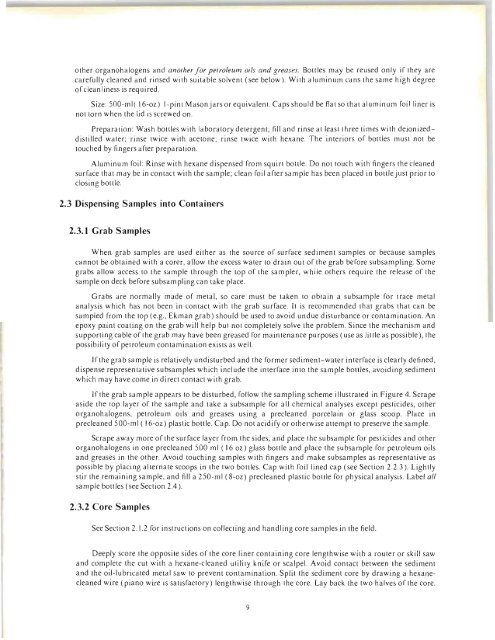Create successful ePaper yourself
Turn your PDF publications into a flip-book with our unique Google optimized e-Paper software.
other organohalogens and another for petroleum oils and greases. Bottles may be reused only if they are<br />
carefully cleaned and rinsed with suitable solvent (see below). With aluminum cans the same high degree<br />
of cleanliness is required.<br />
Size: SOO-m I ( 16-oz) I-pin t Mason jars or eq uivalen t. Caps should be fla t so that alumin urn foi I liner is<br />
not torn when the lid is screwed on.<br />
Preparation: Wash bottles with laboratory detergent; fill and rinse at least three times with deionizeddistilled<br />
water; rinse twice with acetone; rinse twice with hexane. The interiors of bottles must not be<br />
touched by fingers after preparation.<br />
Aluminum foil: Rinse with hexane dispensed from squirt bottle. Do not touch with fingers the cleaned<br />
surface that may be in contact with the sample; clean foil after sample has been placed in bottle just prior to<br />
closing bottle.<br />
2.3 Dispensing Samples into Containers<br />
2.3.1 Grab Samples<br />
When <strong>grab</strong> <strong>samples</strong> are used either as the source of surface sediment <strong>samples</strong> or because <strong>samples</strong><br />
cannot be obtained with a corer, allow the excess water to drain out of the <strong>grab</strong> before subsampling. Some<br />
<strong>grab</strong>s allow access to the sample through the top of the sampler, while others require the release of the<br />
sample on deck before subsampling can take place.<br />
Grabs are normally made of metal, so care must be taken to obtain a subsample for trace metal<br />
analysis which has not been in contact with the <strong>grab</strong> surface. It is recommended that <strong>grab</strong>s that can be<br />
sampled from the top (e.g., Ekman <strong>grab</strong>) should be used to avoid undue disturbance or contamination. An<br />
epoxy paint coating on the <strong>grab</strong> will help but not completely solve the problem. Since the mechanism and<br />
supporting ca ble of the <strong>grab</strong> may have been greased for main tenance pu rposes (use as lit tie as possible), the<br />
possibility of petroleum contamination exists as well.<br />
Tfthe <strong>grab</strong> sample is relatively undisturbed and the former sediment-water interface is clearly defined,<br />
dispense representative sub<strong>samples</strong> which include the interface into the sample bottles, avoiding sediment<br />
which may have come in direct contact with <strong>grab</strong>.<br />
If the <strong>grab</strong> sample appears to be disturbed, follow the sampling scheme illustrated in Figure 4. Scrape<br />
aside the top layer of the sample and take a subsample for all chemical analyses except pesticides, other<br />
organohalogens, petroleum oils and greases using a precleaned porcelain or glass scoop. Place in<br />
precleaned SOO-ml ( 16-oz) plastic bottle. Cap. Do not acidify or otherwise attempt to preserve the sample.<br />
Scrape away more of the surface layer from the sides, and place the subsample for pesticides and other<br />
organohalogens in one precleaned SOO ml (16 oz) glass bottle and place the subsample for petroleum oils<br />
and greases in the other. Avoid touching <strong>samples</strong> with fingers and make sub<strong>samples</strong> as representative as<br />
possible by placing alternate scoops in the two bottles. Cap with foil lined cap (see Section 2.2.3). Lightly<br />
stir the remaining sample, and fill a 2S0-ml (8-oz) precleaned plastic bottle for physical analysis. Label all<br />
sample bottles (see Section 2.4).<br />
2.3.2 Core Samples<br />
See Section 2.1.2 for instructions on collecting and handling core <strong>samples</strong> in the field.<br />
Deeply score the opposite sides of the core liner containing core lengthwise with a router or skill saw<br />
and complete the cut with a hexane-cleaned utility knife or scalpel. Avoid contact between the sediment<br />
and the oil-lubricated metal saw to prevent contamination. Split the sediment core by drawing a hexanecleaned<br />
wire (piano wire is satisfactory) lengthwise through the core. Lay back the two halves of the core.<br />
9

















